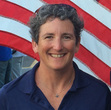Carol Newman Cronin's Blog, page 33
October 24, 2019
Snipe Worlds Reflection
A few weeks ago, I sailed the 2019 Snipe Open Worlds in Ilhabela, Brazil. It was my first time in Brazil for 26 years, and my first time steering a Snipe in a country where they are the most respected doublehanded class. Older, wiser, and in the back of the boat; all told, a much different perspective.
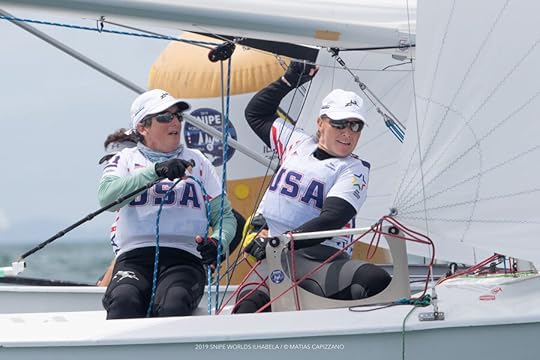
The 1993 Snipe Worlds was my very first international sailing experience, and I was gobsmacked at the level of professionalism South Americans bring to Snipe sailing. This year, I was—yet again—gobsmacked. So much effort and intensity and incredible sailing… But I was also able to pick out those wide-eyed sailors who were experiencing this high level for the first time, and remember back to when it was all almost too much to take in.
I wasn’t the only sailor onsite who’d sailed the 1993 Worlds, and it was great to catch up with friends from around the world who remembered me as a “crew with attitude.” Our goals may have adjusted since then, but for all of us still traveling around the world to sail this quirky 15 foot boat, the class motto continues to ring true. Serious Sailing—of course. But Serious Friendships—that’s what really keeps us all coming back for more.
Last year Kim and I won the Snipe Women’s Worlds, and before I left home several people asked me if we would win this regatta too—not understanding how much better prepared most of the teams would be (and, also, how much bigger they all are). Out of 70 boats, we were the only all-female team, and though our overall finish wasn’t what I’d hoped, we did receive several heartfelt compliments from our competitors. We’re not “the girls” anymore; we’re now “Carol and Kim,” even internationally.
It would be easy to dwell on all the mistakes we made, but instead I’m focusing on how much we learned (and how many fun stories we’ve added to our list). Next year I’ll be celebrating 30 years of Snipe sailing—and I can’t wait to put all those world-class lessons to use.
Photo courtesy Matias Capizzano. For more of his fantastic photos from the regatta, visit his Snipe Worlds 2019 Gallery.
October 17, 2019
Author Conversation #1: Barbara Rogan
I first got curious about Barbara Rogan after devouring (and reviewing) A Dangerous Fiction, the most recent of her eight books. Only eight months later, I found myself reviewing Suspicion. But it wasn’t until I tried to nail down what books I like that I realized I really wanted to interview her.
Though I consider her a fellow author of #coastalfiction, her experiences and perspective on books, publishing, and teaching online are refreshingly different from mine. I’ll let her take it from here.
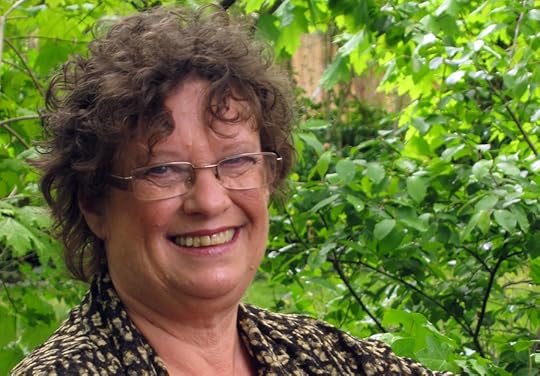
What’s the biggest change you’ve seen since publishing your first novel, in 1982?
The advent of ebooks. When I was a young writer, I used to dream of seeing all my books in print at once, but that was a boon offered only the top bestselling writers. Now thanks to ebooks, my entire backlist is readily available.
On the other hand, I think that the status of being a published author has diminished. Amazon has enabled anyone to self-publish and distribute their own work. As a result, everyone and his brother is an Author now.
Water and coastline seem to be powerful draw many of your characters. Did that imagery sneak up on you, or is it consciously included?
It definitely snuck up on me, since until you pointed it out, I’d never thought of water or the coast as a recurrent theme of mine! But it does make sense. I grew up on an island—Long Island—and the shore has always been my place to go for a shot of serenity, healing and renewal. I may have passed that tendency on to my characters.
In Suspicion, the haunted house at the center of the story overlooks the Atlantic shore, and that was deliberate and is meaningful to the story. The husband of the main character is a chaos physicist, and he was first drawn to the house by that view. The shore, he explains to his wife, is the intersection of two elements and thus ever-changing. The view out their window will never be the same twice. The house itself, which contains both living and dead characters, also represents an intersection of discrete states of being, which results in turbulence.
What’s the biggest difference between writing novels and non-fiction?
There’s more freedom but less safety in fiction. Creating something that never existed before feels like crossing a tightrope over a chasm and knowing that at any moment the rope could disappear. But if you have the stomach for it, fiction is a great instrument for examining the human heart and condition. I believe more truth—or deeper truths—emerge from good fiction.
With non-fiction, there are always odd facts and ungainly events that don’t fit the narrative you’d like to be telling…but you can’t fudge them because they really happened. For this fiction writer, writing non-fiction feels like doing gymnastics in a straight-jacket.
Your writing courses cover both technique and selling advice. Which do you think is your bigger personal strength as a teacher?
I see my role in teaching the business of publishing as one of demystifying what can seem to aspiring writers like a pretty intimidating, unwelcoming industry. Literary agents and editors are just people who went into the field because they really, really love books. (No one does it for the money, which sucks.) That’s something they have in common with most writers. While there are barriers to getting “inside” publishing, once you break through by selling your work, you’re likely to feel very much at home.
But if I had to choose between teaching the business and the craft of writing, I’d choose the craft. For one thing, the best way to get published is to write an irresistible book—and that takes a high degree of craft. What I love most is finding talented writers who need just a bit of help to raise the level of their work, so that it makes the transition from “promising but amateur” to salable fiction.
Thanks to Barbara Rogan for sharing her perspective! Check out her website for info about ongoing courses (as well as the occasional dose of snark). And please feel free to add your own thoughts about writing, publishing, and coastal fiction to this ongoing discussion; I read and appreciate every single comment and email.
Author Conversation: Barbara Rogan
I first got curious about Barbara Rogan after devouring (and reviewing) A Dangerous Fiction, the most recent of her eight books. Only eight months later, I found myself reviewing Suspicion. But it wasn’t until I tried to nail down what books I like that I realized I really wanted to interview her.
Though I consider her a fellow author of #coastalfiction, her experiences and perspective on books, publishing, and teaching online are refreshingly different from mine. I’ll let her take it from here.

What’s the biggest change you’ve seen since publishing your first novel, in 1982?
The advent of ebooks. When I was a young writer, I used to dream of seeing all my books in print at once, but that was a boon offered only the top bestselling writers. Now thanks to ebooks, my entire backlist is readily available.
On the other hand, I think that the status of being a published author has diminished. Amazon has enabled anyone to self-publish and distribute their own work. As a result, everyone and his brother is an Author now.
Water and coastline seem to be powerful draw many of your characters. Did that imagery sneak up on you, or is it consciously included?
It definitely snuck up on me, since until you pointed it out, I’d never thought of water or the coast as a recurrent theme of mine! But it does make sense. I grew up on an island—Long Island—and the shore has always been my place to go for a shot of serenity, healing and renewal. I may have passed that tendency on to my characters.
In Suspicion, the haunted house at the center of the story overlooks the Atlantic shore, and that was deliberate and is meaningful to the story. The husband of the main character is a chaos physicist, and he was first drawn to the house by that view. The shore, he explains to his wife, is the intersection of two elements and thus ever-changing. The view out their window will never be the same twice. The house itself, which contains both living and dead characters, also represents an intersection of discrete states of being, which results in turbulence.
What’s the biggest difference between writing novels and non-fiction?
There’s more freedom but less safety in fiction. Creating something that never existed before feels like crossing a tightrope over a chasm and knowing that at any moment the rope could disappear. But if you have the stomach for it, fiction is a great instrument for examining the human heart and condition. I believe more truth—or deeper truths—emerge from good fiction.
With non-fiction, there are always odd facts and ungainly events that don’t fit the narrative you’d like to be telling…but you can’t fudge them because they really happened. For this fiction writer, writing non-fiction feels like doing gymnastics in a straight-jacket.
Your writing courses cover both technique and selling advice. Which do you think is your bigger personal strength as a teacher?
I see my role in teaching the business of publishing as one of demystifying what can seem to aspiring writers like a pretty intimidating, unwelcoming industry. Literary agents and editors are just people who went into the field because they really, really love books. (No one does it for the money, which sucks.) That’s something they have in common with most writers. While there are barriers to getting “inside” publishing, once you break through by selling your work, you’re likely to feel very much at home.
But if I had to choose between teaching the business and the craft of writing, I’d choose the craft. For one thing, the best way to get published is to write an irresistible book—and that takes a high degree of craft. What I love most is finding talented writers who need just a bit of help to raise the level of their work, so that it makes the transition from “promising but amateur” to salable fiction.
Thanks to Barbara Rogan for sharing her perspective! Check out her website for info about ongoing courses (as well as the occasional dose of snark). And please feel free to add your own thoughts about writing, publishing, and coastal fiction to this ongoing discussion; I read and appreciate every single comment and email.
October 10, 2019
5 Stages of Snipe Charters
I’m sailing the Snipe Open Worlds this week in Ilahbela, Brazil, a well-named (“beautiful island”) mountainous tropical paradise one kilometer off the coast. To get myself here required a bus, a plane, a car, and a ferry. To get my Snipe here required a four thousand mile container ride from Miami for the boat and its eight friends. (I’m still wondering how that container truck made it around some of those hairpin curves.)
All in all, shipping boats was a huge logistical challenge. And it was all totally worth it.
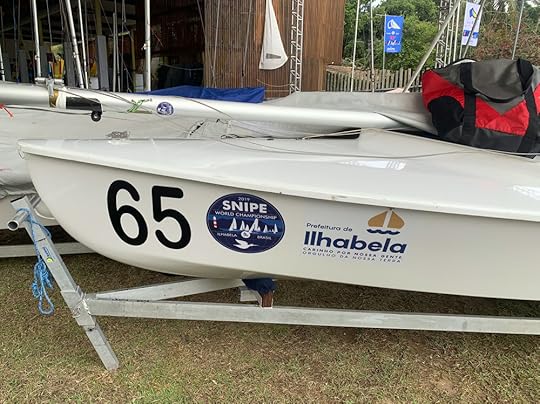
The alternative, of course, was to charter a local boat. For our biggest regatta of the year, I would’ve packed as many tools and spares as I could, wishing I could fit my entire Snipe into checked luggage. For better or worse (or both), Snipe rigging is quite complicated—and quite personal. The muscle memory of the multiple adjustments needed to sail these boats is based on years of habit I don’t even realize I’ve built up—until I step into another boat and try to sail it at the same level.
This is my first Open Worlds sailing my own boat, so I am especially sympathetic to the friends who spent their pre-race days going through what I now call the Five Stages of Chartering. Though the details and timing will vary significantly for each person and each boat, the basics remain the same. Here’s a snapshot.
1. Excitement
“This is going to be the fastest Snipe ever.” This phase begins as soon as you line up the charter and builds momentum slowly, but it ends quite suddenly—either when you first pull the covers off the boat, or when you go sailing for the first time. It may well be the fastest Snipe ever, but it’s not YOURS. The vang line should be blue! Measurements aren’t the same! This quickly morphs into:
2. Grief
“This isn’t the boat I thought it would be.” The boat’s actual abilities don’t matter; what matters is that it doesn’t feel right to you. So you leap to:
3. Denial
“With a little work, we can make it just like our boat at home.” Which takes you to:
4. Work
Out come the tools, line, and hardware. “Can I borrow…” becomes your mantra. While others catch up with friends, go out training, and make a few small refinements to their own boats, you keep your head down trying to check off all the items on your work list, hoping to make the practice race.
And finally…
5. Acceptance
“Forget about the boat, we’re going sailing.” You run out of either time or patience (or both) and realize that you’re never going to make this boat YOURS—which is okay.
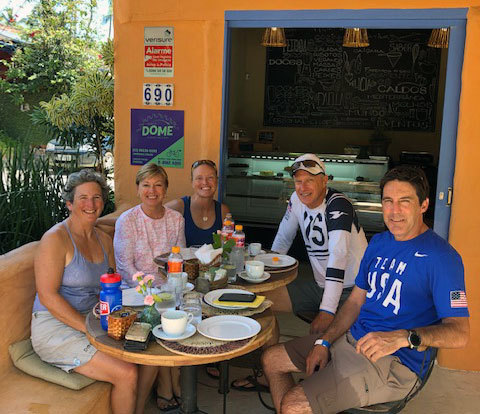
I would argue that the faster you get to acceptance, the better, because it leaves more time for fun meals with friends and sightseeing. But I also know from personal experience that this process can’t be rushed. Each stage is a necessary piece of building a bond with this new member of your team, even if it’s only for this regatta.
I can’t tell you how happy I was to be the observer this time, rather than the one working through these five stages. Next time I charter, I will try to take my own advice and work through to Acceptance as fast as possible.
Snipes are like friends; they all have their quirks. The secret to charter success is to fix and improve what you can, without spending all of your pre-regatta days working on the boat. Because once you get home again, you’ll remember those fantastic lunches with friends from around the world—not what color the vang line was.
October 3, 2019
Ferry to Cooperation Island: Read Chapter One
We’re less than nine months away from Ferry to Cooperation Island’s book-birthday, and I’ve got a special offer for my faithful subscribers: you can read the first chapter right now! I really appreciate your patience on this next novel, and while you’ll still have to wait several months for the rest of the story… the book is already available for pre-order on Amazon.
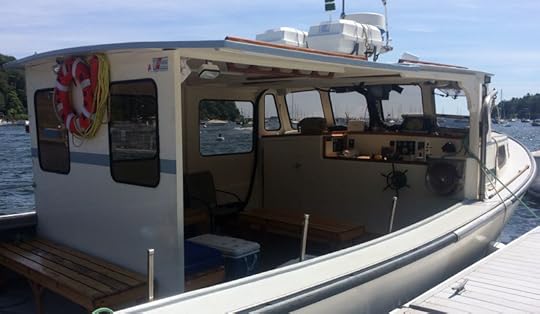
For those of you who’ve read previous drafts, let me know in the comments below or by email how this final version compares to what you remember. Everyone else, let me know what grabs you. Thanks—I read and enjoy every email and comment you send.
September 26, 2019
U.S. Olympic Sailing: All Change
Last week, two departures rocked the world of US Olympic sailing: Greg Fisher (COO) and Malcolm Page (Olympic Chief). US Sailing is currently working to reorganize and refocus the existing staff (all very qualified as well), but that won’t solve the basic structural problems this program has been working around for more than decade.
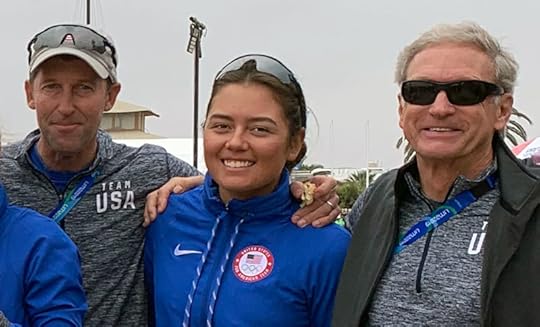 Malcolm Page, Charlotte Rose, and Greg Fisher at the 2019 Pan Am Games, where Team USA won seven medals.
Malcolm Page, Charlotte Rose, and Greg Fisher at the 2019 Pan Am Games, where Team USA won seven medals.I haven’t served on the Olympic Sailing Committee since 2016, but throughout this quad I’ve watched (and interviewed) both Greg and Malcolm, impressed by their vision of a cultural shift that would rebuild the U.S. Sailing Team back to medal-winning consistency. As far as I’m concerned, we were finally working in the right direction—though seriously hampered by a lack of solid and consistent funding, as well as those ongoing organizational challenges. Now two great leaders are gone, and there’s no clear indication of how we will dig ourselves out of this Olympic-swimming-pool-sized medal-less hole.
History repeats
As I think about how we might turn this latest upheaval into an opportunity, I keep returning to the same radical conclusion: we need to rebuild the Olympic program from the ground up. And that sends me right back to the fall of 2004, when a group of us (frustrated by USSailing’s support at the Athens Games) called for a similar reboot. The partial reorganization that followed was, in hindsight, too little, too late; fifteen years later, we’re still trying to catch up with the fully professional model successfully developed by other countries during that same time period.
We can blame a lack of government funding, but it’s also because US athletes have traditionally thrived on independence. My generation grew up without centralized coaching, went sailing because we liked it (with family and friends), and transferred that approach to our campaigns: hiring our own coaches, (mostly) raising our own funds, and taking the crumbs and clothing tossed to us by US Sailing—but never relying on the program for critical support.
That is no longer a medal-winning approach. Professional sport (and the Olympics are indeed professional) requires a centralized structure to guide athletes and shorten their learning curve—while also providing enough support to make multi-quad campaigns economically feasible. As Malcolm put it two years ago, “it’s about removing obstacles, about providing resources and knowledge and guidance to the athlete. And doing it in that [national] structure is where you’ll get the efficiencies. Both cost and performance.” (Read more of his thoughts in The Trump Card, which originally published in the October 2017 issue of Seahorse Magazine.)
While the Olympic Development Program is providing structure for younger athletes (who are posting some great results), the most recent leadership upheaval is teaching the same lesson to yet another generation of Olympic hopefuls: trusting USSailing leads to disappointment. That will make both medal-winning and fundraising harder, for years to come.
So as my mind swirls around where we are, how we got here, and how to learn from our past mistakes, I keep coming back to a basic realization; deep-seated problems cannot be fixed by slapping bandaids on the existing structure. Malcolm believes that “all the pieces of the puzzle are here” in the U.S., and I agree. Disruption is never something we seek out, but here we are… so let’s get out the TNT and blow up the whole thing right now, while we have the chance. All we need is a great leader—and there are at least two out there, looking for a fresh challenge.
September 19, 2019
What Books Do I Like?
I’ve been thinking a lot about how to define the novels I enjoy most, for two quite unrelated reasons:
Trying to find “Goldilocks” comparative titles (not too famous, not too obscure, with a happy-not-sappy ending) for Ferry to Cooperation Island that will help lead the right readers to my next book when it becomes available (June 2020, thanks for asking). The West Ferry Book Group is starting its second season, which leads to monthly discussions about what to read next. Though we end up focused on specific titles, over the past year I’ve homed in on the “type” of book I (and others) tend to recommend.
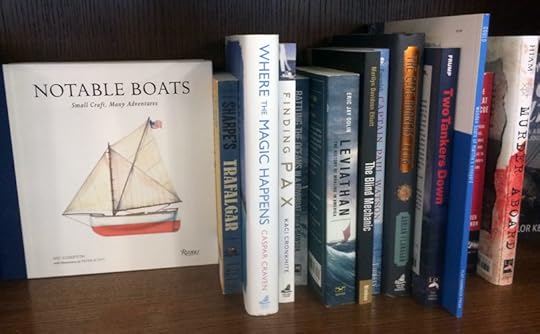
Genres defined
The industry calls this “genre,” though the term really only works for (hah) “genre fiction” (mystery, romance, sci-fi, westerns). Those books have an extremely specific list of expectations and requirements (murder, getting the guy/girl, inventing worlds, riding off into the sunset), so they are easy to categorize.
Everything else is much harder to define, because novels encompass such a wonderfully infinite swath of possibilities in terms of style, world-building, language, and page-turnability: from The Great Gatsby to Room to The Time Traveler’s Wife. Vague terms like “general,” “literary,” “mainstream,” or even “women’s fiction” don’t answer the most important reader’s question of all: “Will I like this?” That’s why the industry has come to rely so heavily on those Goldilocks “comp” titles; it’s easier for us to figure out whether we’ll enjoy a specific book if it is compared to another book that we did enjoy.
“General fiction” usually means that a book combines genres; e.g., a laugh-out-loud mystery, or a romance that includes a car chase. “Literary fiction” prioritizes language over page-turning; at the opposite end of the spectrum is “mainstream fiction” (which, like all of these terms, has developed its own sub-genres). Last but certainly not least, “women’s fiction” creates expectations of a female main character and a “quieter” story (compared to shoot-em-ups and who-dunnits), but it also carries the weight of gender politics; a novel written by a male author will likely be categorized as “literary,” even if the protagonist is a woman.
My favorite type of book
No matter where they’re shelved in the bookstore, my favorite reads will always combine excellence in language with an easy-to-follow (though not completely predictable) plot that ties things together by the end. Action alone isn’t enough to keep me turning the page if the language is sloppy, but flowery words and surprisingly fresh sentence structure won’t keep me reading unless something is happening. Over the past few years, I’ve figured out that this type of book is called “upmarket fiction” (halfway along the spectrum from literary to mainstream), but since few outside the industry know what that means, it’s not a very helpful term. More useful is my own personal list of recommendations: the books I review.
Once an author proves adept at word choice, sentence structure, and story-telling, details like geography, time frame, and characters don’t matter very much. Though I definitely enjoy what I’ve started to call “coastal fiction,” I also love being word-dropped into an entirely new landscape—or into a fresh persona—as long as I’m quickly and confidently able to “see” and “feel” what’s around me. The biggest pleasure of well-written books is experiencing so many different lives and worlds without actually traveling anywhere.
Are you, like me, a lover of #coastalfiction (though you may not have known that was a “thing” until just now)? Let me know in the comments below, or send me an email. I really appreciate every single remark and will do my best to answer any questions you have. Thanks for reading!
September 12, 2019
5 Tips for Lifelong Fitness
Lots of people ask about the supplements I use, but Hammer Nutrition wouldn’t keep me on as a sponsored athlete—and I wouldn’t have such success in the Snipe—without a solid fitness program. So I thought I’d share five tips that deliver benefits, year after year and season after season, in hopes that they might also help others develop a lifelong approach to fitness.
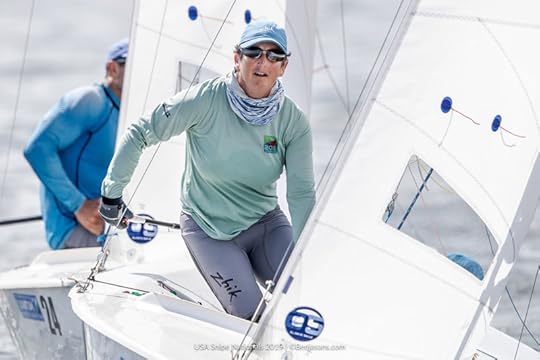 My private name for this photo is “in front of Ernesto.” Thanks to BenjiSans for capturing a rare moment at the 2019 Snipe Nationals!
My private name for this photo is “in front of Ernesto.” Thanks to BenjiSans for capturing a rare moment at the 2019 Snipe Nationals!Tip #1: Find something you enjoy
Over the years, I’ve realized that nothing keeps me fitter than something I really enjoy doing. Since 2012, I’ve been standup paddling (SUP) 2-4 days a week, year-round. It gets me out on the water, provides an excellent (almost) full-body workout, and offers a surprising amount of variety (everything from yoga to wave-riding). In summer, I follow up each morning paddle with a quick swim, and when I’m really pushing hard I supplement that with a few pushups and situps right on the board. My own little triathlon, all without leaving the harbor!
Tip #2: Do something (almost) every day
Working out 5-6 days a week makes it easier to form the habit, even if it’s at a lower intensity on some of those days. Just as those “still-able-to-talk” walks are surprisingly beneficial, even a quick stretch on a day without much spare time is better than staying in bed (or staying up for a second cocktail). Don’t forget to take a day off at least once a week, and make it a special treat.
Tip #3: Have a goal
Situps for situps’ sake are not a powerful motivator. But an upcoming world championship, at a windy venue? That keeps me pushing hard right through the third set. Even if your goal is to walk up the stairs without pausing, it’s important to have something you can focus on besides the actual reps.
Tip #4: Find a partner
I’m lucky enough to share a home gym and a passion for being on the water with my husband, Paul. He is even more motivated than I am to work out every day, and he’s also better at searching out new techniques and equipment that help keep our workouts fresh. Though I fell in love with standup paddling before he did, he’s the one who researched what are now our favorite boards and paddles. If your life partner doesn’t provide this kind of motivation, either find a friend, commit to a regular class at the local gym or yoga studio, or hire a trainer who fits your budget and goals. Nobody can stay motivated on their own.
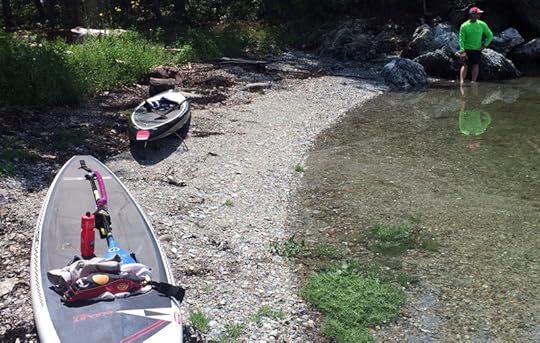 Paddling with Paul varies from flat water island exploration (like this uninhabited camping location near Castine) to downwinder wave-rides. Fitness can be fun!
Paddling with Paul varies from flat water island exploration (like this uninhabited camping location near Castine) to downwinder wave-rides. Fitness can be fun!Tip #5: Change it up
No matter how motivated you are, doing the same routine week after week and year after year gets boring. Here in New England, the weather dictates a change in priorities every few months: more yoga and gym workouts in the winter, more paddling and swimming in the summer. If you’re lucky enough to live in a year-round climate, changing your workouts every month or two is the only way to stay with it in the long term—which is all that really matters. (For a specific example, read SUP Yoga: Crosstraining to a New Perspective.)
It’s also important to vary intensity throughout the year. Identifying “A” goals (like that windy world championship) will help pinpoint when to peak—and make the after-lull even better. Lulls don’t mean becoming a couch potato, though, because more than three days off in a row will make it much harder to get back to your routine. Keep the frequency high, but back off the intensity level—until it’s time to work toward the next peak goal.
Growing older, staying fit
Fitness ebbs faster than it flows, and that unfair truth only seems to become more true with age. That’s why it’s important to do something every day—and the key to doing that is to enjoy the process. Find a workout you enjoy, do it most days, and you too will find yourself reaping lifelong benefits.
How about you? What’s your key to getting and staying fit? Join the conversation below, or send me an email. Your notes are part of what keeps me motivated, and I read every single one.
September 5, 2019
Back to School, Off to Publisher
It’s back to school week, an extremely appropriate time to send my “baby” (the final manuscript of book #4) off to the publisher. Time to celebrate another “chick” leaving the brain nest—I might even shed a few crocodile tears about its fledgling independence!

This book is the longest I’ve written so far (270 pages), with six point-of-view characters, which helps explain why it took so long to finish it. Even after various times when I thought it was complete (starting two years ago), I still found details that needed to be removed (or, in a few cases, embellished) and scenes that could be further streamlined. Since March, I’ve done two full read-throughs and found several corrections to make each time.
Now, at last, it’s out of my hands.
Several people have asked me why there’s so much lead time before it’s available to readers (June 2020). First, the publisher will do a copy edit and then send back corrections, which might lead to several weeks of back and forth. Once that process is completed, they design the layout, which I will also get to check over before “Advance Reader’s Copies” (known in the industry as ARCs) are created. The goal is to make ARCs available to reviewers and other influencers early in 2020.
The rest of the lead time will be taken up with marketing-related stuff: asking for blurbs, getting early reviews, and making sure that readers who like New England coastal fiction or who care about conserving open land find out about it. I’d love it if you all help spread the word—and, ideally, pre-order your copy when the time comes (more about that in December).
That’s what’s ahead. For now, I’m taking some deep breaths and pausing to celebrate this transition to the next phase—not back to school, but off to be published. Cheers!
August 29, 2019
World Championship Logistics
What does it take to go to a world championship in sailing? Well, that’s like asking “how long is a piece of string?” Because it varies from class to class—and even from one world championship within a class to another.
So, what does it take to go to the 2019 Snipe World Open Championship? Pull up a chair; this might take awhile.
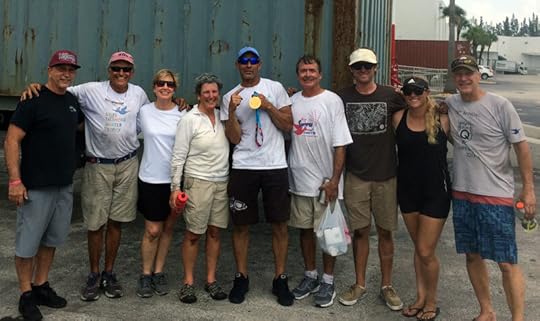 Most of the container-loading crew that teamed up a Sunday in August… in Miami. (Ernesto almost packed his gold medal from the PanAm Games by mistake!)
Most of the container-loading crew that teamed up a Sunday in August… in Miami. (Ernesto almost packed his gold medal from the PanAm Games by mistake!)On a scale of 1 to 10
Last year, Kim and I won the Snipe Women’s World Championship (read Winning a World Championship: 5 Life Lessons). Since it was a rare “home” regatta, logistics were ridiculously easy: first, ask Paul if he would coach us (fortunately, he said yes). Next, drive the trailer over to Sail Newport (25 minutes away). Finally, rig up and go sailing. We didn’t even have to qualify; anyone (female) could show up and sail.
On the degree of difficulty scale, getting ready for last year’s big regatta was pretty much a 1—though I did log several sleepless nights anyway, already understanding Life Lesson #3: Regattas are won (or lost) long before they start.
This year, we’re going to the Snipe Open Worlds in Ilhabela, Brazil—a definite “10” when it comes to preparation and planning.
It all started when we finished second at the very first qualifying regatta, back in March of 2018. The top two boats earned berths, so for once there would be no waiting for the option to trickle down to us. (In hindsight, qualifying was the easiest part.)
Kim and I had sailed two Snipe Open Worlds before, in Denmark (2011) and Italy (2015), so we knew the racing would be incredibly challenging—and that we’d feel like we were missing out if we stayed home. But my excitement was balanced by lingering memories of my last trip to Brazil for the 1993 Worlds (as a crew). Combined with the overwhelming commitment of both money and time that would go into this trip, I spent several months hemming and hawing. We didn’t fully commit to attending the October 2019 regatta until last February.
Gonna be hard
There were two things that pushed me into saying “yes.” One was knowing how much Kim and I have developed as a team since we learned to add rake in 2015—and wanting to test ourselves again on the (open) world stage. The second was realizing how much respect we’ve gained internationally over the past eight years. In the Snipe boat park, we are no longer “the girls;” these days, we are “Kim and Carol.” The eyes of other sailors no longer dodge past us, looking for more interesting sources of nerdy boat-talk. Skippers I respect ask me about our tuning, just in case they ever have to sail a Snipe at a whopping combined dripping-wet weight of 285 pounds. (Standard coed team weight is more like 300-325, especially at a windy venue like Ilhabela.) Off the water, the locals might still treat us like “the girls,” but now that I’m a quarter-century older I am much better equipped to laugh it off.
What it takes
Once we’d signed on for the regatta, we made a long list of logistics. First, nine American teams committed to shipping our boats, after suffering through too many regattas with disappointing charters. Months of logistical email discussions transpired, starting with the most important question: Can you actually fit nine Snipes into one container? It had been done before, we were told, so we marked that item with a relieved “yes.”
Meanwhile, opinions and estimates poured in from around the country: shipping times, paperwork and insurance, what to pack inside each boat—and who would do the actual loading. Finally, ten of us came together on a Sunday morning to stuff nine Snipes into a container.
In Miami.
In August.
(And it was—mostly—fun!)
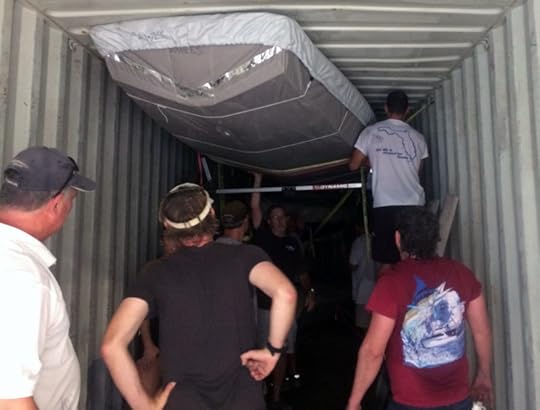 By the second stack of 3, we had the system down. Pre-rig straps, lift, tighten. But even the locals were sweating hard.
By the second stack of 3, we had the system down. Pre-rig straps, lift, tighten. But even the locals were sweating hard.After so many hours of worry, it only took four brain-frying hours for the actual loading—though that’s only because 2019 PanAmerican Games gold medalist Ernesto Rodriguez is also a gold-medal boat-strapper. Now the only worry is what all those carefully-strapped boats and equipment will look like when we open up in Brazil, after four thousand miles of open-ocean and overland travel.
We also have to take care of our own transport and housing, so tack on the usual international travel challenges of buying plane tickets, finding a place to stay, and (in Brazil’s case) getting properly immunized. Kim and I each handled our own travel details, but our “housing czar” (Kim) found us a place within walking distance of the venue. Based on previous experience, I’m sure our accommodations will be a highlight of this next adventure, too.
Just another regatta
Last but certainly not least are the concerns that keep me awake before any big “away” regatta. Do we have the right equipment and any spares we might need? (Everything had to be ordered and organized in time to pack with the boat.) Am I fit enough? (The answer to this question is always ‘no.’) What about coaching, and coach boats? When’s the last possible day to place my Hammer Nutrition order? We also need to make sure our regatta sponsor, WAMIT, is visible on our clothing and boat, since their support is what makes all this possible.
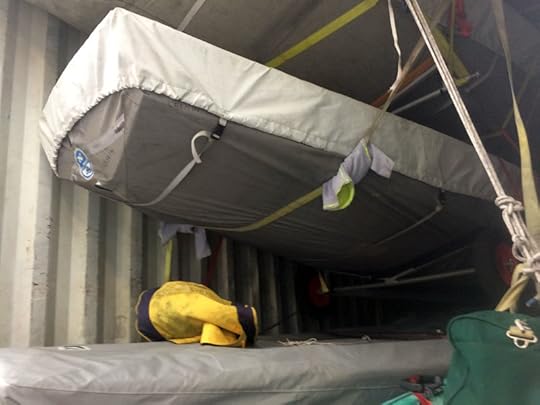 Before the container doors closed, I took one last picture of my boat. See you in Brazil!
Before the container doors closed, I took one last picture of my boat. See you in Brazil!Stretch goals can take many forms. This year’s world championship is definitely a 10 on the logistical scale, and we won’t know until it’s over whether it also will be a 10 on the fun scale. Obviously, I’m betting both time and money that the answer to that is yet another “yes.”
PS: Kim’s article about how much we learn from hard regattas is definitely worth a read. And please let me know what your next regatta challenge looks like; I read every comment and email.

